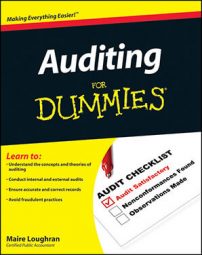For many audits, looking at 10 percent of the records that a company has produced during the past year may be just right. But that number isn’t always going to work. Your job as an auditor is to choose records for your sample that accurately represent a certain population. A sampling unit is the item in the population that the auditor actually examines. To select the right records — and the right number of them — you must take the following steps prior to making your decisions
Auditors refer to any group of records that belong in a specific category as a population. For example, the rent expense population is all invoices, leases, documents, and so on that support the amount of the expense shown on the income statement.
Become familiar with the business and its environment.
Look at the business purpose, location, and management philosophy. You want to become as knowledgeable about the company as you can.
Assess the audit risk level.
Getting a handle on each company’s unique level of audit risk increases the effectiveness and efficiency of the sampling process.
For example, if your assessment shows that your risk of arriving at the wrong audit conclusion is low, you can feel pretty confident that a smaller sampling of the company’s records is sufficient. If your audit risk is high, your sampling population may need to be more extensive.
Understand the client’s internal control procedures.
Understanding the company’s internal controls helps you decide on an appropriate and adequate sample size. Strong internal controls allow you to move forward with a smaller sample of records, and weak internal controls demand a larger sample.
Select the correct sampling method.
You can use a hammer or a rock to drive a nail into a piece of wood. Both do the job, but using the right tool for the job (the hammer) makes completing the task easier. Picking the right sampling method is your way of picking the right tool for this sampling job. Obviously, you must also make sure you use the sampling method the right way. If you don’t apply the sampling method correctly, your sample may be invalid.
The control is that client invoices are correct. An error or deviation in this control would be if the cost per unit on the client invoices doesn’t agree with the standard price list, and there’s no explanation for the deviation (such as the fact that the client was given a discount). Even if an explanation exists, you still have a deviation if the proper authority didn’t okay the discount.

